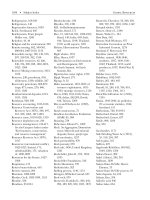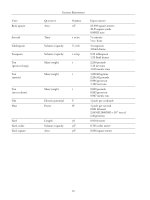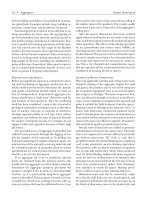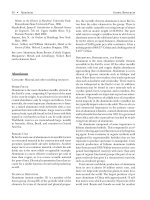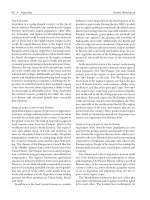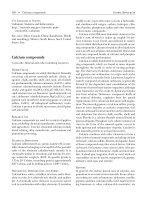Encyclopedia of Global Resources part 5 pot
Bạn đang xem bản rút gọn của tài liệu. Xem và tải ngay bản đầy đủ của tài liệu tại đây (292.28 KB, 10 trang )
their durability and ability to be polished to an attrac
-
tive gloss finish. Examples include large building or-
naments, countertops, and headstones for graves.
Sand and gravel are found in areas with past or ex-
isting streamflow. In many cases, the segregating as-
pects of streamflow have sized the sand and gravel so
that further sizing is minimized. Crushed stone, how-
ever, is produced in mining operations, and the oper-
ator has control over the size range of the finished
product. For the most part,these operations are at the
surface and are known as quarries. Some stone is pro-
duced in underground mining operations, with the
high quality of the stone justifying the additional ex-
pense of this type of operation. Many quarries operat-
ing in a particularly desirable deposit of stone con-
tinue to pursue it by going underground.
Preparations for Mining
Before any significant expense is committed to locat-
ing and developing an aggregate production site, a
market study is performed to determine the amount
and quality of materials needed within a certain ra-
dius of transportation. Experienced aggregate pro-
ducers usually have a “sixth sense” about the need for
and location of their products. After the marketing
study has been completed, a quarry site is located by
geological exploration techniques such as identifica-
tion of surface outcrops of material or inference,
through regional studies of rock type. Even surface
vegetation can indicate the type of material beneath
the surface. Limestone terrains, for example, do not
support acidic-soil vegetation because of their high
pH values.
The potential source of aggregate is identified and
outlined more precisely through the digging of test
pits for samples of the materials or by drilling test
holes and analyzing the samples obtained. Again, the
inherent size of the naturally occurring materials and
the estimated expense of preparing them to market
specifications are critical points that help determine
whether a site is to be developed.
If an aggregate site is to be produced, mineral
leases are obtained from the mineral owners, who
usually own the aggregate as well as deeper minerals.
Sometimes the aggregate producer purchases the
property outright if the location is environmentally
sensitive or if a particularly long-lived aggregate
source is identified. If the property is leased, the lease
is usually for a fixed term, perhaps ten years, with op
-
tions to continue the lease for additional terms. A roy
-
alty is paid to the owner of the minerals according to
the market value of the products. The royalty usually
varies from 2 percent to 10 percent of the aggregate’s
selling price.
After the quarry dimensions have been verified,
applications to develop the site are made to the local,
state, and federal agencies that will regulate all aspects
of site operation. The effects of the mining operation
on air, groundwater and surface water, wildlife, ar-
chaeological sites, and various natural processes must
be determined. This process can be extremely expen-
sive and consume several years. An environmental im-
pact study and report may be necessary in certain ar-
eas. This a very detailed and comprehensive report
that incorporates all the environmental factors to be
considered in locating the pit or quarry.
Aggregate Mining Operations
When all applicable permits and releases have been
obtained, mining of the aggregate begins. For sand
and gravel, the products can be recovered using sim-
ple excavation equipment such as front-end loaders,
pan scrapers, or dredges. The stone in quarries, how-
ever, has inherent strength such that it is usually nec-
essary to use explosives to fragment the material and
make it suitable for bulk transport from the quarry.
Blasting is used to dislodge stone from the “face,” or
quarry wall. Almost any commercial explosive can be
used for this purpose, but a mixture of ammonium ni-
trate and fueloil has emerged overthe past several de-
cades as the most cost-efficient explosive. Dynamite is
still used but in smaller quantities than before.
Several rows of blast holes are drilled at predeter-
mined distances from the free quarry face. These dis-
tances are engineered to ensure efficient rock break-
age without unnecessary “fly” rock, or rock that is
propelled outside the desired blasting area. Explosive
cord is also extensively used in blasting operations.
This product, with an almost instantaneous ignition
rate, is especially useful when “delay” blast rounds are
used. In delay blasting, millisecond delay sequences
cause the first row of blast holes to be initiated, then
subsequent rows rearward from the free face to be ig-
nited after predetermined delays. This technique,
now standard in nearly all quarry blasting proce-
dures, results in much greater blasting efficiency.
Dimension stone may also be removed by explo-
sives, but the drill holes are very closely spaced, and
the explosive is limited to the amount necessary to cut
the block of dimension stone to the desired size and
10 • Aggregates Global Resources
not fragment it further. High-pres
-
sure water jets or rock-cutting saws
are also used in removing dimension
stone from the quarry. Since the value
of the dimension stone depends on
the largest physical units minable,
the stone must be gently dislodged so
that it remains intact.
Blasting, while indispensable to
the crushed stone industry, is also
one of the predominant problems as-
sociated with it. The noise, vibration,
and dust resulting from blasting op-
erations, combined with the fact that
quarries are usually located near
populated areas, frequently bring
ongoing conflict between producers
and nearby residents. As a result,
blasting is done carefully, and its side
effects are measured to ensure that it
is done within the guidelines set and
enforced by regulatory agencies.
The blasted material, after it is removed from the
quarry face, is loaded by front-end loaders or shovels
into large trucks for transportation to the surface
preparation plant. The timing of the quarry floor
loading operation is a continually challenging prob-
lem involving machinery size and speed, operator ef-
ficiency, and positioning. Occasionally it is necessary
to reduce the sizes of blasted fragments that are too
large to beloaded and transported easily with existing
equipment, and small amounts of explosives may
again be necessary on the quarry floor. Transporta-
tion from the quarry floor is usually by truck, belt
conveyor, or bucket conveyor, depending on the oper-
ating system in effect at the quarry. Removal of dimen-
sion stone poses a special problem because the large
sizes demand gentle handling and require vehicles ca-
pable of transporting the large, heavy units of stone.
Large track-mounted crawlers, rubber-tired vehicles,
or cranes are frequently used for this task.
Sizing the Material
Blasted materials are transported from the quarry
to be reduced in size (“comminuted”) using adjust-
able crushers, sorted into various sizes to suit the cus-
tomer’s specifications, washed to remove unwanted
extraneous materials such as clays, and stockpiled
awaiting shipment. Typically, crushers operate by
chewing on the material (“jaw crushers”) or passing
the material through rollers (“roll crushers”). When
crushed, the material assumes sizesvarying from dust-
sized particles to pieces equivalent to the crusher open-
ing. Most of these crushedproducts,eventhefinesizes,
have some value, so the sizing operation is indispens-
able to an efficient quarry serving multiple customers.
Sizing may be based on a number of physical prin-
ciples, such as the ability to pass through or be re-
jected by sized openings (sieving), the tendency to
drop out of a fluid stream (liquid classification), or
the ability to be propelled through the air to a certain
distance (air classification). If the materials have par-
ticular physical or chemical characteristics (magne-
tism, for example), other sizing operations can be de-
signed to take advantage of them. Sieves (screens)
frequently have a vibration device attached to them to
prevent clogging and expedite the sorting process.
Screening can be fully wet or dry, but merely moist
materials cannot be separated in a screening opera-
tion.
The end resultofsizingishavingseveralsizedprod-
ucts in which the size range within a sized product is
quite narrow. If necessary, sized materials can be fur-
ther classified by washing techniques designed to re-
move the fine sizes inherent in the crushing process.
Practical sizes of quarry products range from dust
sizes of a few microns in diameter to cubic-shaped di
-
mension stone having dimensions exceeding 6 or 9
Global Resources Aggregates • 11
The sizesofsand canvary dramatically.The large-grain sand,from England, isapproxi-
mately 2 millimeters in diameter. The small-grain sand is from Tunisia.
meters. For most applications,however, practical sizes
include sands from 1.65 millimeters through gravels
around 0.6 centimeter to 1.2 centimeters in diameter,
to stone sizes 2.5 centimeters to 7.6 centimeters in
diameter, to fist-sized material used for foundation
bases in construction, to football-sized riprap. The ul-
timate goal of a stone and rock producer is to market
100 percent of the products generated in its opera-
tion. While this is a practical impossibility, the most
efficient producers have been able to come remark-
ably close to this goal.
Environmental and Citizenship Concerns
Virtually all the activities of quarry operation have
some undesirable side effects. Siltation problems are
inherent in stream-based operations. Blasting gener-
ates noise, dust, and vibrations. Trucking activities do
the same, and theypresenta hazard to mixed automo-
bile traffic if public roads are used for transportation.
Surface facilities are prone to emitting dust, and fluid
classification equipment produces sludge that must
be handled. While not toxic in themselves, these by-
products from aggregate production are objection-
able and must be dealt with according to stringent
regulations from municipal, state, and federal agen-
cies. The closer an aggregate producer is to populated
areas, the greater the inherent problems are (and the
harder it is for the producer to be considered a good
community citizen), but moving farther from these
areas brings increased transportation costs and may
make the producer uncompetitive. Moreover, most
quarries are below the water table, which means that
a constant inflow of groundwater must be pumped to
a nearby creek or river. Although this water is fre-
quently used in the crushing and sizing processes, it
must still be pumped, routed, stored, and eventually
disposed. Desludging equipment may also be neces-
sary, further increasing the complexity of the opera-
tion.
Most successful aggregate producers have recog-
nized and come to terms with the environmental con-
sequences of their businesses. Blasting procedures
are carefully engineered to minimize unwanted side
effects and are scheduled at times that are least objec-
tionable to those living or working nearby. A bag-
house (a type of giant vacuum-cleaner bag) traps
dusts produced by crushing operations and, in turn,
frequently creates its own marketable product. Elec-
trostatic precipitators are also used to remove and col-
lect dust-sized material. Fines (powder or very small
particles) from classification facilities are collected in
sediment ponds that can be periodically “mined” to
yield a marketable product. In addition to being a
good environmental citizen, an aggregate producer
should have a visually pleasing facility if it is located in
or near populated areas. Well-kept grounds, clean
equipment, and storage areas free of debris are marks
of the conscientious operator.
12 • Aggregates Global Resources
Crushed Stone Sold or Used in the United States, 2007
Number of
Quarries Metric Tons
Total Value
(dollars)
Unit Value
(dollars)
Calcareous marl 3 2,820,000 18,800,000 6.68
Dolomite 137 72,500,000 562,000,000 7.75
Granite 384 241,000,000 2,620,000,000 10.88
Limestone 2,123 1,020,000,000 8,280,000,000 8.13
Marble 21 7,580,000 71,100,000 9.38
Sandstone and quartzite 188 47,700,000 398,000,000 8.35
Shell 5 2,850,000 24,200,000 8.47
Slate 33 3,820,000 37,000,000 9.68
Traprock 361 105,000,000 1,030,000,000 9.82
Volcanic cinder and scoria 46 6,630,000 48,800,000 7.36
Miscellaneous stone 435 94,100,000 781,000,000 8.30
Source: Data from U.S. Bureau of Mines, Mineral Yearbook, 2007. U.S. Government Printing Office, 2009.
Operational Life Span
Although a large sand and gravel pit or stone quarry
may remain open for decades, there is an ultimate life
span to each location. Besides the restrictions of min-
ing to the edges of the deposit or to the legal property
limits of the miners’ leases, there is a practical depth
beyond which a quarry must either go underground
or face significantlyincreased costs of lifting themate-
rial to the surface. If the decision is made to abandon
the mine site, a large excavation remains that may en-
compass many hectares and be as much as 60 to 90
meters in depth. With the closing of the pit or quarry,
the excavation quickly fills with water, and an im-
poundment, sometimes having very steep sides, be-
comes part of thelandscape.Topsoil initially removed
to expose the minable aggregate must be hauled away
or stored nearby. Spoil that was removed and dis-
carded during the quarrying operation may now be
visually objectionable and must be remedied.
If all these remedial activities are included as a part
of the overall life cycle of the pit or quarry, then a
desirable residential location may be created. It is
common to see upscale housing developments built
around old pits andquarries, withthe impoundments
becoming favorite targets of sport fishermen. They
are also frequented by migratory birds and other wild-
life favoring large bodies of fresh water.
Charles D. Haynes
Further Reading
Blatt, Harvey, Robert J. Tracy, and Brent E. Owens. Pe-
trology: Igneous, Sedimentary, and Metamorphic. 3d ed.
New York: W. H. Freeman, 2006.
Chatterjee, Kaulir Kisor. Uses of Industrial Minerals,
Rocks, and Freshwater. New York: Nova Science,
2009.
Grotzinger, John P., et al. Understanding Earth. 5th ed.
New York: W. H. Freeman, 2007.
Hockensmith, Charles D. The Millstone Industry: A
Summary of Research on Quarries and Producers in the
United States, Europe, and Elsewhere. Jefferson, N.C.:
McFarland, 2009.
Kogel, Jessica Elzea, et al., eds. “Stone and Rock.” In-
dustrial Minerals and Rocks: Commodities, Markets,
and Uses. 7th ed. Littleton, Colo.: Society for
Mining, Metallurgy, and Exploration, 2006.
Philpotts, Anthony R., and Jay J. Ague. Principles of Ig-
neous and Metamorphic Petrology. 2d ed. New York:
Cambridge University Press, 2009.
Raymond, Loren A. Petrology: The Study of Igneous, Sedi
-
mentary, and Metamorphic Rocks. 2d ed. Boston:
McGraw-Hill, 2002.
Smith, M. R., and L. Collis, eds. Aggregates: Sand,
Gravel, and Crushed Rock Aggregates for Construction
Purposes. 3d ed. Revised by P. G. Fookes et al. Lon-
don: Geological Society, 2001.
Tarbuck, Edward J., and Frederick K. Lutgens. Earth:
An Introduction to Physical Geology. 9th ed. Illustrated
by Dennis Tasa. Upper Saddle River, N.J.: Pearson
Prentice Hall, 2008.
Weiss, Norman L., ed. SME Mineral Processing Hand-
book. 2 vols. New York: Society of Mining Engineers
of the American Institute of Mining, Metallurgical,
and Petroleum Engineers, 1985.
Web Sites
Natural Resources Canada
Canadian Minerals Yearbook, Mineral and Metal
Commodity Reviews
/>indu/cmy-amc/com-eng.htm
U.S. Geological Survey
Crushed Stone: Statistics and Information
/>commodity/stone_crushed/index.html#mcs
U.S. Geological Survey
Dimension Stone: Statistics and Information
/>commodity/stone_dimension/index.html#mcs
See also: Abrasives; Cement and concrete; Dimen-
sion stone; Granite; Igneous processes, rocks, and
mineral deposits; Limestone; Marble; Metamorphic
processes, rocks, and mineral deposits; Quarrying;
Sand and gravel; Slate.
Agricultural products
Categories: Plant and animal resources; products
from resources
Agricultural products encompass all commodities de-
rived from the production of animals and the growing
of crops to be used by humans for food, fiber, shelter, me
-
dicinal applications, or aesthetic purposes.
Global Resources Agricultural products • 13
Background
A nation’s ability to sustainan agricultural system with
the capacity to feed, shelter, and clothe its population
is perhaps its greatest natural resource. The human
domestication of certain animals and cultivation of
certain food crops predate written history. In modern
society, the diversity of products that can be produced
via agricultural technology is enormous. Major agri-
cultural commodities can be divided into those that
come from animals and those that are derived from
plants.
Agricultural Products from Animals
The major animal-derived products can be divided
into edible and inedible red meat products, milk and
milk products, poultry and egg products, and wool
and mohair. Red meat products refer primarily to
those products that come from cattle (beef and veal),
swine (pork), sheep (lamb and mutton), goats
(chevon), and, to a lesser extent, other animals
such as horses and buffalo.
Other than the meat itself, edible products
from red meat animals include meat scraps used
to make processed meats such as frankfurters and
bologna; organ meats such as liver, tail, tongue,
tripe (stomach), and sweetbread (thymus); and
tallow or lard. The major inedible red meat prod-
ucts include rendered fat, which is used to make
soap and formula animal feeds; bone meal, used
in fertilizer and animal feeds; manure; and hides
or skins, which are tanned and used to make
leather products.
Milk and milk products, also referred to as
dairy products, are major components of the hu-
man diet in many countries. Whole milk with part
or all of the fat removed is sold as low-fat or skim
milk. Evaporated and condensed milk refers to
milk from which approximately 60 percent of the
water has been removed, and dry or powdered
milk has had at least 95 percent of the water re-
moved. Cultured milk products such as butter-
milk, yogurt, sour cream, and cottage cheese are
produced via fermentation by the addition of ap-
propriate bacterial cultures to fluid dairy prod-
ucts. Cream products are separated from liquid
milk and have a milk fat content of not less than
18 percent. Butter is made by separating the but-
terfat from either milk or cream and contains at
least 80 percent by weight milk fat. Cheese is pro
-
duced through the microbialaction of a variety of
bacteria and fungi on whole milk. Ice cream, ice milk,
sherbet, and frozen custard are produced by freezing
a variety of liquid milk products in combination with
sugar and other ingredients.
Poultry products are nutritious and relatively inex-
pensive, and they are used by humans throughout the
world. Broiler chickens provide most of the world’s
poultry meat, but turkeys, roaster chickens, mature
laying hens (fowl), ducks, geese, pigeons, and guinea
hens are also consumed and may be more important
than chickens in some parts of the world. Much of the
poultry meat is processed into preformed products
such as poultry rolls or nuggets, canned products, or
cured and ground products such as frankfurters, bo-
logna, turkey ham, or salami. Other than meat, poul-
try also provides eggs. The majority of the world’seggs
are now produced by chickens specifically selected to
lay large numbers of eggs, but eggs from the other
birds listed above are sometimes eaten. Eggs can be
14 • Agricultural products Global Resources
Harvested corn is loaded onto a grain-hauling truck. (AP/Wide
World Photos)
further processed and sold as liquid eggs or dried
eggs. There is also an industry based on the meat and
eggs fromtheratitebirds,suchastheostrichandemu.
The hair covering the skin of some farm animals is
also considered an agricultural product. The two most
important of these are wool from sheep and mohair
from angora goats. Wool or mohair can be sheared
annually from the same sheep or goat. The cleaned
and processed fibers are woven into yarn, which can
then be used to make carpet or cloth.
Agricultural Products from Plants
Agricultural products that are derived from plants
are also diverse. They can be subdivided into timber
products, grain crops, fiber crops, fruit crops, nut
crops, vegetable crops, beverage crops, spice and drug
crops, ornamental crops, forage crops, and other cash
crops such as sugarcane, tobacco, artichoke, and rub-
ber. Timber products include those materials derived
from the trees of renewable forests. The two major
products are lumber for building and paper, but
other products such as pine tar, resin, and turpentine
are also extracted from trees.
More cultivated land is devoted to the production
of grain crops, also known as cereal grains, and fiber
crops than to any other agricultural crop. Cereal
grains are the edible seed from a variety of grasses.
Throughout history, these crops have been primarily
responsible for sustaining large human populations
and domestic animal herds. The products from the
world’s major grain crops include corn, wheat, oats,
barley, rye, rice, and derivatives such as grain-based
cereals and flours. Rice is the leading seed crop in the
world and is the principal food crop of about half the
world’spopulation.Corn, barley, rye, and rice are also
used to produce alcoholic beverages. Grainsorghums
are also produced in large quantities in the United
States, but this grain is primarily used as feed for live-
stock. Cotton, flax, and hemp are the principal fiber
plants grown in the United States, although less im-
portant crops such as ramie, jute, and sisal are also
grown. While these plants are grown primarily for
their fiber, which is used to make textiles, rope, twine,
and similar products, other products such as cotton-
seed oil and linseed oil from flax are also produced.
Fruits from a variety of perennial plants are har-
vested for their refreshing flavors and nourishment.
Fruits can be subdivided into temperate, subtropical,
and tropical crops. Grapes, a temperate fruit grown
for table use, winemaking, and raisins, account for ap
-
proximately 25 percent of the fruit production of the
world. Examples of other temperatefruits include the
pome fruits (apple and pear), stone fruits (plum,
peach, apricot), kiwi fruit, and berry fruits (straw-
berry, raspberry, blackberry, cranberry, and blue-
berry). Tropical and subtropical fruit crops include
banana, pineapple, mango, papaya, avocado, date,
fig, olive, and citrus fruits (orange, lemon, and grape-
fruit). In addition to providing fresh fruit, the prod-
ucts from fruit crops can be canned, dried, converted
to juices, and used to make jams and jellies or special
products such as olive oil.
Nut crops refer to those woody plants that produce
seed with firm shells thatseparate them from an inner
kernel. Nuts are generally considered to be luxury
food. They are often eaten as a delicacy (either fresh
or canned) or consumed with candy or other sweets.
Major temperate nut crops include walnut, almond,
chestnut, pistachio, pecan, and hazelnut. Tropical
nut crops include the coconut, cashew,Brazil nut,and
macadamia. Nuts are characteristically rich inoil.The
inedible tungnut is grown exclusively for its oil.
Vegetable crops are extremely diverse and range
from starchy calorie sources (potato) to food that sup-
plies vitamins and minerals (broccoli). Examples of
the major vegetable crops include the edible legumes
(beans, soybeans, peas, lentils, and peanuts); roots,
tubers, and bulbs (potato, sweetpotato, taro, yam, cas-
sava, onion, sugar beet, and carrot); solanaceous fruits
(tomato, eggplant, and chili pepper); salad plants
(lettuce, endive, chicory, parsley, and garden cress);
cole crops (cabbage, cauliflower, broccoli, brussels
sprouts, and radish); and vine crops (cucumbers, wa-
termelon, cantaloupe, pumpkin, squash, and gourd).
Like fruit crops, vegetable produce can be served
fresh, canned, frozen, or in an assortment of juices.
The world’s three most popular nonalcoholic bev-
erages—coffee, tea, and cocoa—are produced in the
tropics. These products represent a major proportion
of the tropical world’s agricultural exports, and their
production is the major industry in many tropical
countries. Many plants or plant parts that possess
strong aroma and flavor are grown for the purpose of
producing spices. Because of the diverse biochemis-
try of plants, some crops are cultured for the produc-
tion of medicinal drug compounds. There are more
than two hundred spice and drug plants; some of the
more common products are peppermint, nutmeg,
garlic, vanilla, allspice, cinnamon, black pepper, mus
-
tard, opium, quinine, belladonna, and digitalis.
Global Resources Agricultural products • 15
Ornamental and forage crops are not consumed by
humans. Ornamental crops are grown for aesthetic
purposes and are divided into florist crops (flower
and foliage plants) and landscape crops (nursery
plants). Common ornamental crops include rose, or-
chid, carnation, chrysanthemum, and a variety of
shrubs. Forage crops are grown to feed livestock and
include a host of small grain grasses, clover, alfalfa,
and a variety of straw crops for haymaking.
D. R. Gossett
Further Reading
Akinyemi, Okoro M. Agricultural Production: Organic
and Conventional Systems. Enfield, N.H.: Science
Publishers, 2007.
Brody, Aaron L., and John B. Lord, eds.DevelopingNew
Food Products for a Changing Marketplace. 2d ed. Boca
Raton, Fla.: CRC Press/Taylor & Francis, 2008.
Field, Thomas G., and Robert E. Taylor. Scientific Farm
Animal Production: An Introduction to Animal Science.
9th ed. Upper Saddle River, N.J.: Prentice Hall,
2008.
Janick, Jules. Horticultural Science. 4th ed. New York:
W. H. Freeman, 1986.
Ward, Janet D., and Larry T. Ward. Principles of Food
Science. Tinley Park, Ill.: Goodheart-Willcox, 2002.
Web Sites
Agriculture and Agri-Food Canada
Producers
/>afficher.do?id=1165871799386&lang=eng
U.S. Department of Agriculture
Animal Production
/>7_0_1OB?navid=ANIMAL_PRODUCTION&pare
ntnav=AGRICULTURE&navtype=RT
U.S. Department of Agriculture
Crop Production
/>7_0_1OB?navid=CROP_PRODUCTION&parent
nav=AGRICULTURE&navtype=RT
See also: Agriculture industry; Corn; Horticulture;
Monoculture agriculture; Plant domestication and
breeding; Plant fibers; Plants as a medical resource;
Rice; Rubber, natural; Sugars; Wheat; Wood and
timber.
Agriculture industry
Categories: Plant and animal resources; obtaining
and using resources
The ability to produce sufficient food and fiber to feed
and clothe its population is the most important natu-
ral resource a nation can have. In modern urban soci-
eties, it is also the natural resource that is most often
taken for granted.
Background
The beginnings of agriculture predate the written his-
tory of humankind. No one knows when the first crop
was cultivated, but at some time in the distant past hu-
mans discovered that seeds from certain wild grasses
could be collected and planted in land that could be
controlled, the end product of which could later be
gathered for food. Most authorities believe this oc-
curred at about the same time in both the Old World
and New World, some eight thousand toten thousand
years ago. The earliest attempts at growing crops were
primarily to supplement the food supply provided by
hunting and gathering. However, as the ability to pro-
duce crops increased, people began to domesticate
animals, and their reliance on hunting and gathering
decreased, allowing the development of permanent
human settlements.
As far back as six thousand years ago, agriculture
was firmly established in Asia, India, Mesopotamia,
Egypt, Mexico, Central America, and South America.
The earliest agricultural centers were located near
large rivers that helped maintain soil fertility by the
deposition of new topsoil with each annual flooding
cycle. As agriculture moved into regions that lacked
the annual flooding of the large rivers, people began
to utilize a technique known as slash-and-burn agri-
culture. In this type of agriculture, a farmer clears a
field, burns the trees and brush, and farms the field.
After a few years, soil nutrients become depleted, so
the farmer must repeat the process. This type of agri-
culture is still practiced in some developing countries
and is one reason that the tropical rain forests are dis-
appearing at such a fast rate.
Until the nineteenth century, most farms and
ranches were family-owned, and most farmers prac-
ticed sustenance agriculture: Each farmer or rancher
produced a variety of crops sufficient to feed himself
and his family as well as a small excess to be sold for
16 • Agriculture industry Global Resources
cash or bartered for other goods or services. Agricul-
tural tools such as plows were made of wood, and al-
most all agricultural activities required human or ani-
mal labor. This situation placed a premium on large
families to provide the help needed to tend the fields.
The Industrial Revolution changed agriculture just as
it did almost allother industries. Eli Whitney invented
the cotton gin in 1793. The mechanical reaper was in-
vented by Cyrus McCormick, and John Lane and John
Deere began the commercialmanufactureofthesteel
plow in 1833 and 1837, respectively. These inventions
led the way for the development of the many different
types of agricultural machinery that resulted in the
mechanization of most farms and ranches. By the
early part of the twentieth century, most agricultural
enterprises in the United States were mechanized.
The Industrial Revolution produced a significant
change in society. The industrialized nations were
gradually transformed from agrarian societies into ur
-
ban societies. People involved in agricultural produc
-
tion left the farms to go to the city to work in the facto-
ries. At the same time, there was no longer a need for
large numbers ofpeople to produce crops. As aresult,
fewer people were required to produce more agricul-
tural produce for an increasing number of consum-
ers. This trend continues in developing nations with
more rural dwellers, adding to the overcrowding in
urban centers.
Modern Agriculture
As populations continued to grow, there was a need to
select and produce crops with higher yields. The
Green Revolution of the twentieth century helped
to make these higher yields possible. Basic informa-
tion supplied by biological scientists allowed the agri-
cultural scientists to develop new, higher-yielding vari-
eties of numerous crops, particularly the seed grains
that supply most of the calories necessary for main
-
tenance of the world’s population. These higher-
yielding crop varieties, along with improved farming
Global Resources Agriculture industry • 17
A farm manager practices weed control in a soybean field as an aspect of the farm’s weed-tillage system. (United States Department of
Agriculture/Keith Weller)
methods, resulted in tremendous increases in the
world’s food supply. The new crop varieties also led to
an increased reliance on monoculture. While the
practice of growing only one crop over a vast number
of hectares has resulted in much higher yields than
planting multiple crops, it has also decreased the ge-
netic variability of many agricultural plants, increased
the need for commercial fertilizers, and produced an
increased susceptibility to damage from a host of bi-
otic and abiotic factors. These latter two develop-
ments have resulted in a tremendous growth in the
agricultural chemical industry. Today’s modern ag-
ricultural unit requires relatively few employees, is
highly mechanized, devotes large amounts of land to
the production of only one crop, and is highly reliant
on agricultural chemicals such as fertilizers and pesti-
cides.
Agricultural Diversity
With all the diversity that has occurred in modern ag-
riculture, the industry is subdivided into many differ-
ent specialties. On the animal side of the industry,
there is the beef industry, which deals with the pro-
duction of beef cattle; the dairy industry, which fo-
cuses on the production of dairy cattle, milk,andmilk
products; the horse industry, which produces horses
for work, sport, or pleasure; the sheep and goat indus-
try; the swine industry, which deals with the produc-
tion of pigs and hogs; and the poultry industry, which
is concerned with the production of commercial birds
and bird products such as eggs. Those agricultural in-
dustries that deal with plants include agronomy, the
production of field crops (wheat, cotton, and so on);
forestry, the growth and production of trees; and hor-
ticulture. Horticulture is subdivided into pomology,
the growth and production of fruit crops (oranges,
apples, and so on); olericulture, the growth and pro-
duction of vegetable crops (tomatoes, lettuce); land-
scape horticulture, the growth and production of
trees and shrubs that are used in landscape design;
and floriculture, the growth and production of flow-
ering plants used in the floral industry.
The various agriculture industries produce a tre-
mendous number of different agricultural products.
Those agricultural products that are derived from
plants can be subdivided into timber products (such
as lumber, furniture), grain products (wheat, oats),
fiber products (cotton, flax), fruit products (grapes,
peaches), nut crops (pecans, hazelnuts), vegetable
products (lettuce, cabbage), beverage products (tea,
coffee), spice and drug crops (garlic, mustard,
opium, quinine), ornamental crops (carnation, chry-
santhemum), forage crops (alfalfa, clover), and other
cash crops,suchassugarcane,tobacco,artichoke, and
rubber.
The animal industries provide products such as red
meats from cattle (beef and veal), swine (pork), sheep
(lamb and mutton), and goats (chevon). Milk and
milk products, also referred to as dairy products, in-
clude milk, ice cream, and cheeses. Broiler chickens
provide most of the world’s poultry meat, but turkeys,
roaster chickens, mature laying hens (fowl), ducks,
geese, pigeons, and guinea hens are also consumed
and may be more important than chickens in some
parts of the world. Other than meat, poultry also pro-
vides eggs. The hair covering the skin of some farm
animals is also considered an agricultural product.
The two most important of these are wool from sheep
and mohair from angora goats.
Impact on Other Natural Resources
While there have been tremendous increases in agri-
cultural productivity through the use of modern agri-
cultural practices, these same practices have had a sig-
nificant impact on some other natural resources. Soil
is one of the most overlooked and misunderstood re-
sources. Most people think of soil as an inert medium
from which plants grow. In reality, topsoil—that up-
per 15 to 25 centimeters of the Earth’s terrestrial sur-
face in which nearly all plants grow—is a complex
mixture of weathered mineral materials from rocks,
partially decomposed organic molecules, and a large
number of living organisms. The process of soil for-
mation is very slow. Under ideal conditions, topsoil
can form at a rate sufficient to produce a layer of
about 1 millimeter thick when spread over 1 hectare
per year. Under less favorable conditions, it can take
thousands of years to produce this small amount of
soil. With proper management, topsoil can be kept
fertile and productive indefinitely. However, many ag-
ricultural techniques lead to the removal of trees and
shrubs, which providewindbreaks,ortothedepletion
of soil fertility, which reduces the plant cover over the
field. These practices have exposed the soil to in-
creased erosion from wind and moving water, and as a
result, as much as one-third of the world’s current
croplands are losing topsoil faster than they can be re-
placed.
Because plants require water in order to grow, agri
-
culture represents the largest single global user of
18 • Agriculture industry Global Resources
water. Worldwide, about 70 percent of all fresh water
withdrawn from groundwater supplies, rivers, and
lakes is used to irrigate crops, and almost 15 percent
of the world’s croplands are irrigated. Water usage
varies among countries. Some countries have abun-
dant water supplies and irrigate liberally, while water
is scarce in other countries and must be used carefully.
Because as much as 60 percent of the water intended
for irrigation is lost through old pipes and canals or
to evaporation before the water reaches the field,
the efficiency of water use in some countries can be
very low. There is no doubt that irrigation has dra-
matically increased crop production in many areas,
but some irrigation practices have been detrimental.
Overwatering can lead to a waterlogging of the soil.
Waterlogging cuts off the supply of oxygen to the
roots, and the plants die. Irrigation of crops in dry cli-
mates can often result in salinization of the soil. In
these climates, the irrigation water rapidly evaporates
from the soil, leaving behind the mineral salts that
were dissolved in the water. As the salts accumulate,
they become lethal to most plants. Some experts esti-
mate that as much as one-third of the world’s agricul-
tural soil has been damaged by salinization. There is
also an argument as to whether or not the increased
usage of water for agriculture has decreased the sup-
ply of potable water fit for other human uses.
Plants require sunshine, water either from rainfall
or irrigation, carbon dioxide from the atmosphere,
and thirteen mineral nutrients from the soil. Of these,
calcium, magnesium, nitrogen, phosphorus, and po-
tassium are required in the greatest amounts. Cal-
cium and magnesium are plentiful in soils located in
dry climates, but in wetter climates, these nutrients
are often leached through the soil. In these regions,
calcium and magnesium are returned to the soil in
the form of lime, which is primarily used to raise the
soil pH. Nitrogen, phosphorus, and potassium are the
nutrients most often depleted from agricultural soils,
and these nutrients are often referred to as the fertil-
izer elements. Because thesenutrients stimulate plant
growth and usually greatly increase crop yields, it is
necessary to apply them to the soil regularly in order
to maintain fertility.
The amount of fertilizer applied to the soil has in-
creased more than twentyfold in the past fifty years.
While this increase in the use of fertilizers has more
than tripled the worldwide crop production, it has
also caused some problems. The increased produc
-
tion of fertilizers has required the use of energy and
mineral resources that could have been used else
-
where. In many cases, farmers tend to overfertilize.
Overfertilization not only wastes money but also con-
tributes to environmental degradation. Fertilizer ele-
ments, particularly nitrogen and phosphorus, are
carried away by water runoff and are eventually de-
posited in the rivers and lakes, where they contribute
to pollution of aquatic ecosystems. In addition, ni-
trates can accumulate in underground water supplies.
These nitrates can be harmful if ingested by new-
borns.
Modern agriculture, as it is practiced in the indus-
trialized nations, consumes large amounts of energy.
Farm machinery utilized in planting, cultivating, har-
vesting, and transporting crops to market consumes
the largest supplies of liquid fossil fuels such as gaso-
line or diesel. Theenergy required to produce fertiliz-
ers, pesticides, and other agricultural chemicals is the
Global Resources Agriculture industry • 19
An agronomist cradles a box of broccoli on a farm in Salinas, Cali
-
fornia. (United States Department of Agriculture)
